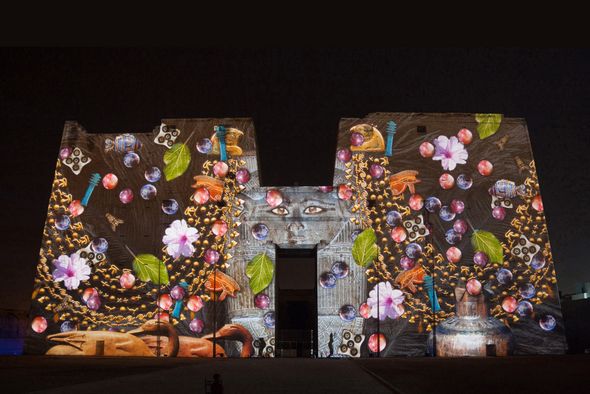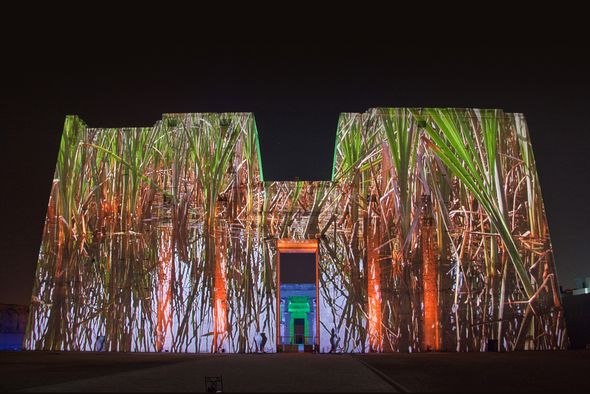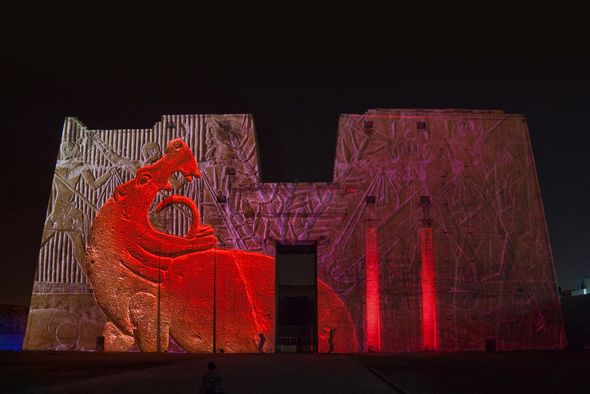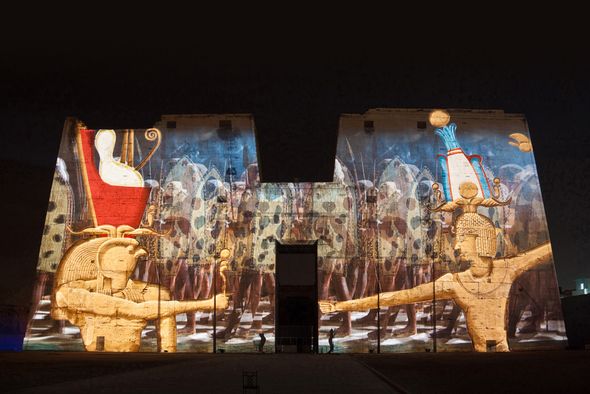Horus-Tempel
Facade projection in Edfu/Egypt
A spectacular visitor attraction at the Temple of Horus on the west bank of the Nile features large-format projection to wow tourists at the night-time sound and light show, discovers Tom Hall.
If you have ever watched the James Bond film The Spy Who Loved Me, you will know that the pyramids have a history of spectacular projection shows. Raising the bar on this tradition, albeit without Roger Moore's eyebrow-raising turn, was the challenge Christie faced when it was asked to provide the lighting for a series of events along the Nile. Egyptian technology company Horizon for Trading and Contracting staged its first sound and light show for tourists visiting the Pyramids of Giza back in 2002. Its head of engineering, Wael Gouda, was unaware that this would lead to the company eventually presenting five such spectaculars at temples along the Nile - and its largest gig to date, illuminating the Temple of Horus in Edfu. Concentrating on the stretch between Luxor and Aswan, Horizon followed the Pyramids show with similar productions at the Philae Temple in Aswan, and then the Temple of Karnak at Luxor and The Temple at Abu Simbel. The Temple of Horus show features large-scale projection from four Christie Roadster S+20K 3-chip DLP devices. It is the first time that large-format projection has been used in any of these shows. Projecting a distance of 70m onto the main gate, it will highlight the final destination in a three-stage visitor attraction.
Marking a leap forward from previous sound and light shows, the Edfu spectacular was billed to be staged three times a night. To win the tender, issued by Egyptian government-owned company Misr Company for Sound and Light, Horizon had to fight off competition from Spanish and French tenders. After winning the contract, Horizon set about reviewing suppliers able to offer the kind of projection output needed. 'We put out feelers to two companies and Christie made the most favourable response,' says Gouda. As part of the tender process, Christie's sales consultant in Africa, Phil Lord, jetted out to demonstrate the kit to Horizon, Misr Company for Sound and Light and Casa Magica, which provided artistic direction for the show. As a result, the S+20Ks were chosen over more powerful 30,000-lumen projectors.The artistic directors were satisfied that the features of Christie were suitable for this application - and, in fact, we are able to use just two 20Ks stacked, with the lamps run at 60 per cent of their power,' says Lord. 'This way we are not only energy-efficient, but we also have full redundancy in the event of any faults.'
Cool runnings
The projectors are mounted 70ft from the ground on pylons and encased in two 2sqm temperature-controlled cabinets. The sealed air-conditioned cases are designed to overcome the hazards of dust, sand and heat (in the daytime, when the projectors are in storage, temperatures can soar to 45 degsC). 'With most of the structure IP65-rated, it is fine for the conditions,' explains Gouda. 'The cabinet, which is built in Egypt, is of good quality and we have tested the cooling and isolation to ensure it is suitable - including making sure that by day the storage temperature is okay.' The creative team on the Temple of Horus project includes lighting designers, sound composers and artistic directors. The show itself offers an experience in which the contents and presence of the original site are transposed into an artistic pageant of architecture, image, light, music and speech under the guidance of the artistic team. They collate high-quality image sources and set up specific photoshoots for a show lasting 37 minutes, the final 16 minutes of which are provided by a giant Christie projection onto the 40x40ft temple fascia.
Bringing Horus to life
The ancient temple itself is located on the west bank of the Nile; the second largest in Egypt (after Karnak), it is regarded as one of the best preserved. Dedicated to the falcon god Horus, it was built in the Ptolemaic period between 237 and 57 BC. The show depicts the building of the temple, presents a day in the life of a temple dweller, from sunrise to sunset, and tells the mythological story of Isis, Osiris, Horus and Set. The footage is recorded on digital media, with speech and music updated regularly, and it is fed over fibre-optic cable to the projectors from an AV Stumpfl media player running Wings Platinum 4 software. The show control also sends DMX signals to the lighting, which includes Martin Pro and Griven heads, while the soundtrack is delivered through a Meyer sound system. Equipped with multi-lingual headsets, up to 1,000 people have to date attended the three nightly shows, which offer a different dimension to the daytime guided tours.
Realized by: www.elofoq.com




